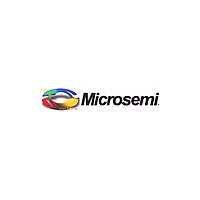LX1681 Microsemi Corporation, LX1681 Datasheet - Page 8

LX1681
Manufacturer Part Number
LX1681
Description
VOLTAGE - MODE PWM CONTROLLERS
Manufacturer
Microsemi Corporation
Datasheet
1.LX1681.pdf
(9 pages)
LX1681/1682
8
FET SELECTION
Synchronous Rectification – Lower MOSFET
The lower pass element can be either a MOSFET or a Schottky
diode. The use of a MOSFET (synchronous rectification) will result
in higher efficiency, but at higher cost than using a Schottky diode
(non-synchronous).
Non-Synchronous Operation - Schottky Diode
A typical Schottky diode, with a forward drop of 0.6V will dissipate
0.6 * 15 * [1 – 2/5] = 5.4W (compared to the 1.8 to 3.5W dissipated
by a MOSFET under the same conditions).
cycles. The use of a dual Schottky diode in a single TO-220
package (e.g. the MBR2535) helps improve thermal dissipation.
Operation From A Single Power Supply
The LX1681/1682 needs a secondary supply voltage (V
provide sufficient drive to the upper MOSFET. In many applica-
tions with a 5V (V
situations where only 5V is present, V
a bootstrap (charge pump) circuit, as shown in Figure 4 (Typical
Applications section).
Schottky diode (D
on. This scheme provedes a V
or approximately 9.5V with V
sufficient gate drive to the external MOSFET in order to get a low
R
rectification mode is likely to result in faster turn-on than in non-
synchronous mode.
LAYOUT GUIDELINES - THERMAL DESIGN
A great deal of time and effort were spent optimizing the thermal
design of the demonstration boards. Any user who intends to
implement an embedded motherboard would be well advised to
carefully read and follow these guidelines. If the FET switches
have been carefully selected, external heatsinking is generally not
required. However, this means that copper trace on the PC board
must now be used. This is a potential trouble spot; as much
copper area as possible must be dedicated to heatsinking the FET
switches, and the diode as well if a non-synchronous solution is
used.
ground and V
with VIAS to the power device tabs. The TO-220 and TO-263
cases are well suited for this application, and are the preferred
packages. Remember to remove any conformal coating from all
exposed PC traces which are involved in heatsinking.
DS(ON)
Power dissipated in the bottom MOSFET will be:
This power loss becomes much more significant at lower duty
The capacitor (C
In our VRM module, heatsink area was taken from internal
P
[IRL3303 or 1.76W for the IRL3102]
. Note that using the bootstrap circuit in synchronous
D
= I
2
* R
CC
DS(ON)
(continued)
planes which were actually split and connected
2
), and then boosted up when the FET is turned
CC
4
) is alternatively charged up from V
) and a 12V (V
* [1 - Duty Cycle] = 3.51W
C1
CC
voltage equal to 2 * V
= 5V. This voltage will provide
P R O D U C T D A T A B O O K 1 9 9 6 / 1 9 9 7
C1
V
C1
) supply are present. In
O L T A G E
can be generated using
P
A P P L I C A T I O N I N F O R M A T I O N
R O D U C T I O N
- M
CC
- V
CC
O D E
via the
DS
C1
(D
) to
2
),
P W M C
D
General Notes
As always, be sure to provide local capacitive decoupling close to
the chip. Be sure use ground plane construction for all high-
frequency work. Use low ESR capacitors where justified, but be
alert for damping and ringing problems. High-frequency designs
demand careful routing and layout, and may require several
iterations to achieve desired performance levels.
Power Traces
To reduce power losses due to ohmic resistance, careful consid-
eration should be given to the layout of traces that carry high
currents. The main paths to consider are:
in order to minimize resistance and hence power losses. It is also
recommended that, whenever possible, the ground, input and
output power signals should be on separate planes (PCB layers).
See Figure 2 – bold traces are power traces.
Layout Assistance
Please contact Linfinity’s Applications Engineers for assistance
with any layout or component selection issues. A Gerber file with
layout for the most popular devices is available upon request.
check Linfinity's web site for further application notes.
A T A
All of these traces should be made as wide and thick as possible,
Evaluation boards are also available upon request. Please
Input power from 5V supply to drain of top MOSFET.
Trace between top MOSFET and lower MOSFET or Schottky
diode.
Trace between lower MOSFET or Schottky diode and ground.
Trace between source of top MOSFET and inductor and load.
O N T R O L L E R S
S
FIGURE 2 — Enabling Linear Regulator
LX168x
H E E T
GND
5V Input
Output
Copyright © 1999
Rev. 1.0 5/99









